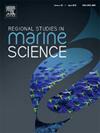Zooplankton community in coastal waters of the southern patagonian shelf during early autumn: Diversity and distribution pattern linked to regional water circulation
IF 2.1
4区 环境科学与生态学
Q3 ECOLOGY
引用次数: 0
Abstract
Zooplankton composition, abundance and distribution in the south end of the Argentine continental shelf, although documented on a large scale, is still poorly constrained at higher spatial resolution in many specific areas. This work explores the distribution and composition of zooplankton off the coast of Tierra del Fuego during early autumn, to expand the knowledge about the biological significance of this marine region, located between the Magellan Strait and the Beagle Channel. During an oceanographic survey in early autumn 2014, samples were collected with a 300 μm mesh Bongo net. A total of 20 zooplanktonic groups were recorded and 37 species identified. The Margalef index ranged between 2.24 and 4.18 among sampling stations, with high values in stations 27 and 25, which exhibited the highest diversity of copepods, chaetognaths, mysids, and amphipods. Copepods were the most abundant (730 ind/m³ in average), with Drepanopus forcipatus as the dominant species, followed by mysids, mainly of the species Neomysis monticelli, and the euphausiid species Euphausia lucens and Thysanoessa gregaria. The non-metric multidimensional scaling and hierarchical cluster analysis revealed two distinct geographic sectors, defined by species´s abundance and presence/absence. High zooplankton abundance was observed near the coast at 54°S, where sea surface temperatures were warmer, with a decrease towards deeper and colder waters. Local circulation dynamics inferred from global reanalysis data, including the southward advance of a coastal tongue of warm water during the sampling days and the formation of an anticyclonic vortex, significantly influenced zooplankton distribution in the area.
求助全文
约1分钟内获得全文
求助全文
来源期刊

Regional Studies in Marine Science
Agricultural and Biological Sciences-Ecology, Evolution, Behavior and Systematics
CiteScore
3.90
自引率
4.80%
发文量
336
审稿时长
69 days
期刊介绍:
REGIONAL STUDIES IN MARINE SCIENCE will publish scientifically sound papers on regional aspects of maritime and marine resources in estuaries, coastal zones, continental shelf, the seas and oceans.
 求助内容:
求助内容: 应助结果提醒方式:
应助结果提醒方式:


